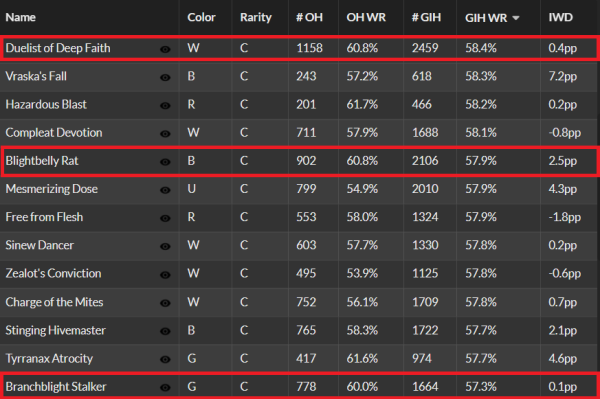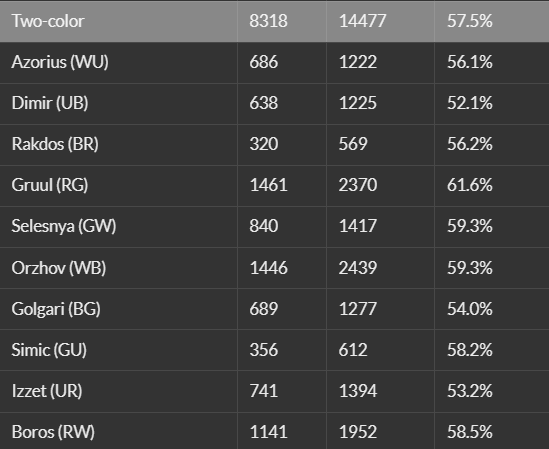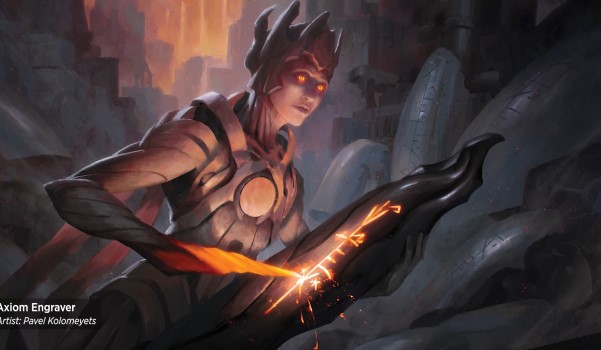Are you a Quiet Speculation member?
If not, now is a perfect time to join up! Our powerful tools, breaking-news analysis, and exclusive Discord channel will make sure you stay up to date and ahead of the curve.
As is true in all limited formats, two-drops play a critical role in defining what each color and each archetype are doing. They are vital pieces to examining how well each deck achieves those goals. Phyrexia: All Will Be One (ONE) is no exception.
The Landscape of ONE
ONE Limited is a very punishing format. It's aggressive, and synergies tend to snowball out of control. Many of the games quickly devolve into races, and if our first play is on turn three, we're probably not going to make it out alive. The two-drops help to establish those synergies and pressure our opponent.
Ones in ONE?
The one-drops in the format range from reasonable to very good. In our preview article, we even went so far as to claim that Crawling Chorus would be the best common in the set. Although it currently boasts the third best win rate amongst commons, less than one percent behind Contagious Vorrac and Chimney Rabble, that debate still rages on. Getting on board early, however, has become an immutable law of the land.
For the most part, the ones contribute to the same synergies the two-drops do; however, they are far less populous within the set.
Half-Price for Similar Effects
While there are many similarities, the biggest drawback is the sizing. The reduction of size between ones and twos has typically held them back. Still, in this format, the one-drops thrive.
Oil vs. Toxic
If we're playing in paper, we'd better have our dice ready. The oil decks want to have plenty of them. We want to flood the board with oil-coated permanents. The oil payoffs care about the number of permanents with oil counters, while disregarding the number of counters on any given permanent.
Got Dice?
In an oil deck, any card that enters the battlefield with oil can generate advantage. However, since these games end so quickly, we want to make sure the card in question can hold its own. In an aggressive format, there's no guarantee we'll be able to assemble specific combos.
Conversely, the toxic decks care about one die in particular: the one tracking our poison. We might, however, not be overly concerned with getting all the way to ten. In some toxic decks, the important threshold is the three required to unlock corrupted.
Toxic Twos
The first batch of two-drops are the toxic brawlers. It's important for Toxic to get those first points of poison in early. Branchblight Stalker and Duelist of Deep Faith do this as early attackers. The duelist boasts a little more consistency, as the first strike can embarrass early blockers. The Stalker, conversely, is begging to be blocked. Its 3/1 sizing and toxic 2 makes opponents want to get in front of it if possible.
While both of these cards play well with combat tricks, the Stalker needs them. However, if we build around the 3/1 properly, we can reap the benefits of a faster clock. Cards like Adaptive Sporesinger, Flensing Raptor, and especially Prosthetic Injector play very nice and help the elf get through. Still, we shouldn't have to do this much work to get the most out of our two-drops.
Blightbelly Rat is another option for poisoning our opponent. It also has toxic, but the death trigger can help further our poison plan while extracting additional value.
The important thing to remember with these cards is that our opponent is going to want to block them. No one wants poison counters, especially not early. Because we can anticipate early blocks, cheap combat tricks will be especially potent. The toxic trio all perform well in the format.

Black's Black Sheep
Pestilent Syphoner is narrow, but can be effective. It does a great job getting that first poison counter, and sometimes it can be a persistent source. However, the measly body means that the card only does one thing. It doesn't trade well, gets bricked easily, and can't help you on defense. We need to really want to get in poison damage to maximize this, though it's a terrifying combo with Necrogen Communion.
This card has been featured in the UB Toxic Control deck, but that hasn't come together particularly well. If we're playing this early, and planning on proliferating with cards like Experimental Augury and Thrummingbird, we need to be concerned with our own life total. This is a racing format. Opponents will be attacking us on the ground and have potent answers of their own.
While these decks can be scary, they more often leave us with seven or eight poison counters before falling short. As a result, UB, the natural home for the Syphoner, has the lowest win rate in the format of two-color decks.

Corrupted Payoffs
Only two of the common two-drops qualify as corrupted payoffs, and only one of them is any good. At this point in the format, there simply isn't enough time or a good enough reason to be spending our turns regrowing Fleshless Gladiator. In theory it's a nice piece to pair with Pestilent Syphoner. In reality, this isn't what we want to be doing in the late-game and it's definitely not what we want to be doing in Toxic.
On the other hand, Incisor Glider gets out of control fast. Once our opponent is corrupted , the glider attacks as a 2/4 while giving an anthem to the rest of the team. This effect can end games very quickly.
Oiling Up
While the toxic decks really want to get damage across, the oil decks prioritize putting dice on the board. There are only two options for common two-drops here. Axiom Engraver has overperformed expectations, currently with a 60.6% GIH WR. While the best defense is probably a good offense in ONE, this card lets us play a slower game. It keeps dice on the board, blocks well (especially when holding up Hexgold Slash and Free from Flesh to offset opposing combat tricks), and helps us smooth out draws. Early on it develops our hands; late game it lets us redraw our lands.
Predation Steward is replaceable, but contributes to the plan. Activating its ability rarely feels good in oil decks, but can be a valuable way to push through toxic damage. That being said, three mana, at sorcery speed, while tapping your creature feels like a waste of a lot of resources. While it has some versatility, this card is not a priority.
The problem with Ichor Synthesizer isn't an issue of power. This format just doesn't give us time to set up our cards, and that's what this creature needs. The 1/3 body is fine, but not particularly impactful. It can get counters, but because it doesn't enter with them, it can also slow down our development. Turn four is big for the oil decks, and they want to slam something powerful; think an Urabrask's Anointer, Cinderslash Ravager, attacking with our Kuldotha Cackler or ramping out a Oil-Gorger Troll. Not entering with the counter has been costly.
We can supplement the shortage of oil two-drops with ones like Sawblade Scamp, Rustvine Cultivator and Glistener Seer. Outside of the Engraver, the oil two-drops are underwhelming, but getting counters on the board is important.
The Art of Artifacts
In this format, we may end up playing any two-drop in a pinch. Getting on the board early is just that necessary. Still, we should try to avoid including Malcator's Watcher or Escaped Experiment. These don't offer much as proactive game pieces, and that's the name of the game in ONE. We want to be pressuring or developing. These cards don't do that well, and while we might want an artifact for our Eye of Malcator or Unctus's Retrofitter, there are better options.
Take Mandible Justiciar, a reasonable alternative. It's fine on its own, and being able to trade off while gaining life is excellent. The lifelinker plays well with tricks and has a few synergies in the format, but one toughness can be a liability against Toxic, which is the most likely matchup to ignore the additional life it provides. Additionally, there is some crossover synergy between the mites and the artifacts, which could potentially open up an avenue for Incisor Glider to play well in some versions of UW Artifacts.
Utility Twos
Barbed Batterfist is a three-power attacker that leaves material behind upon trading. It's not incredibly powerful, but it has synergies as a noncreature spell and as an artifact. While we don't always have time to juice the synergies, this card doesn't ask anything of us. It's Roc Hunter, but we can bounce it to rebuy the token, or move the equipment to block one-power creatures better. We can boost an evasive attacker's power, which makes it a natural partner with Ichor Synthesizer or fliers. This card is excellent in any red deck and its one of the few cards in the format that's truly flexible.
Unfortunately, most of the flexible cards in the format are underwhelming. Shrapnel Slinger usually plays like a split-card; either Grizzly Bears or Shatter. Dune Mover is another middling flexible option. Its having toxic means that we can splash while still building out our board. Copper Longlegs offers proliferate, which lets us fill in empty spots to help with oil or toxic. Truth be told, all three of these options are pretty weak. We may find value bringing them out of the sideboard, but we should try and avoid these three.
Ranking the Twos
- The Great: Axiom Engraver, Barbed Batterfist, Duelist of Deep Faith, Incisor Glider
- The Good: Blightbelly Rat, Ichor Synthesizer, Mandible Justiciar
- Playable: Branchblight Stalker, Predation Steward, Pestilent Syphoner
- The Bad: Dune Mover, Malcator's Watcher, Fleshless Gladiator
- The Ugly: Copper Longlegs, Escaped Experiment, Shrapnel Slinger
This is a format where we need to make sure we have a plan and that we can deploy it fast. Having effective two-drops is a massive part of executing in this format. Make sure that you hit the ground running, because if our first play is on turn three, we're already a step behind.
If the format has gotten off to a frustrating start, reconsider your mana curve. Make sure you have a deck that can consistently start early, with cards that contribute to a plan. Start fast, build strong, and play tight.




